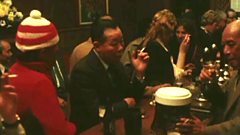
Bombing of the 1976 Ideal ΒιΆΉΤΌΕΔ Exhibition
John Stapleton visits the 1976 Ideal ΒιΆΉΤΌΕΔ Exhibition in London. On 27 March β76 a Provisional Irish Republican Army (PIRA) bomb had exploded in a litter bin at the exhibition.
Reporter John Stapleton is seen having his bag searched by a security guard before entering the 1976 Daily Mail Ideal ΒιΆΉΤΌΕΔ Exhibition in London.
On 27 March 1976 a Provisional Irish Republican Army (PIRA) bomb had exploded in a litter bin at the exhibition; 85 people were injured.
At the time of the bombing visitors were not frisked on entering the hall, they only had their bags searched. Since the bomb everyone is frisked before entering.
The bomb used by the terrorists was a βsmoking bombβ; this does not have an automatic timing device, just a smoke signal to show that it is about to go off. Lieutenant Colonel George Styles (a former commander of the British Armyβs Bomb Disposal Unit in Northern Ireland) explains that this system gives the bomb layer a warning if the bomb is going wrong.
John Stapleton then hears from Alexander McPherson, a security guard who was standing beside the litter bin when the PIRA bomb exploded. Mr. McPherson describes the horrific injuries inflicted on those in the vicinity, βIt sickened me at first and it made me feel very angryβ.
CONTEXT
England became a republican bomb target after Bloody Sunday when members of the parachute regiment shot dead 13 people in Londonderry on 30 January 1972.
On 22 February 1972 the Official IRA planted a bomb at the Aldershot headquarters of the Parachute Regiment; the regimentβs soldiers had been responsible for the Bloody Sunday killings. The bomb killed seven - a gardener, the regiment's Roman Catholic padre and five women in the kitchens.
A year later the Provisional Irish Republican Army, now eclipsing the Official IRA, sent its first unit to London.
The first, and still one of the most infamous operations, involved sisters Dolores and Marion Price; the Price sisters and nine accomplices placed four car bombs in London on 8 March 1973.
Ten of the team were apprehended as they attempted to leave Heathrow and two bombs were defused. However, the remaining two bombs, one of which was outside the Old Bailey, exploded; one man was killed and some 180 other people were injured.
M62 bombing: undeterred by the jailing of the Price sisters and others, the PIRA continued its campaign. One of the most horrific bombings came in February 1974 when an IRA unit planted a bomb on a coach carrying servicemen and their families, killing 11 people.
The bombing led to a controversial miscarriage of justice when Judith Ward, a woman with a history of mental illness, was jailed for that attack and others.
Later that same year, an IRA unit planted bombs in two pubs in Guildford, Surrey. The explosions killed one civilian, two Scots Guards and two members of the Womenβs Royal Army Corps. A further sixty-five persons were wounded.
Birmingham pub bombing: in November 1974, the IRA carried out one of its most devastating attacks when 21 people were killed in another pub bombing in Birmingham. As the public demand for justice put the police under pressure to get results, 10 people were arrested and jailed for both this latest incident and Guildford.
However, after long campaigns, the Guildford Four and the Birmingham Six were released in 1989 and 1991 respectively; the Court of Appeal having found that they had been wrongly convicted.
Balcombe Street Gang: following the collapse of the PIRA's 1974-1975 ceasefire, a fresh campaign began, led by a four-man team who became known as the Balcombe Street Gang.
Martin O'Connell, Edward Butler, Harry Duggan and Hugh Doherty carried out a wave of bombings - detonating their first ten devices in just five days.
The gang also killed Ross McWhirter, the co-editor of the Guinness Book of Records, after he had offered Β£50,000 for information leading to the arrest of the team.
However, after a botched attack on a Mayfair restaurant, the four men took local residents hostage (in an apartment on Balcombe Street in London) and began a tense stand-off with the police. After six days the four surrendered, providing a major victory to the security forces.
The men were charged with 10 murders and 20 bombings and jailed for life.
During the trial they claimed responsibility for the Guildford pub bombings and another incident in Woolwich, acts which were not added to the list of charges.
Duration:
This clip is from
More clips from 02/04/1976
-
![]()
Paul Hill and Gerry Conlon
Duration: 03:22
-
![]()
Alleged bomb factory
Duration: 02:25
-
![]()
Terrorists in London
Duration: 02:13
-
![]()
The continuing danger from PIRA bombs
Duration: 01:43
More clips from Nationwide
-
![]()
A Passion for Steam Trains—23/09/1975
Duration: 10:35
-
![]()
Eddie Braben on Liverpool—10/09/1979
Duration: 13:44
-
![]()
Southend Holiday—24/08/1973
Duration: 10:25
-
![]()
Scarva—10/07/1981
Duration: 08:28









